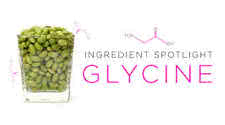fitFLEX Nutrition Corner: Glycine and Growth Hormone

Advanced Nutrition & Researched-Proven Studies
Bodybuilders who refuse to resort to drugs such as anabolic steroids often seek natural alternatives. These usually consist of various nutrients that some research shows may bring about a rise in hormones associated with muscular growth, including testosterone, insulin and growth
hormone, or GH.
The most common nutritional elements used for such purposes are amino acids. This use is based on studies showing a rise in endogenous growth hormone after subjects ingested a number of different amino acids. For example, one often-quoted Italian study involved oral consumption of
1,200 milligrams of the amino acids arginine and lysine. Taking these aminos together resulted in an eightfold increase in growth hormone secretion in the study subjects.
No one, however, was able to explain why taking either of the two amino acids separately caused almost no discernable GH-1 release in the same subjects. Arginine is one of the more potent GH releasers, which explains why a formerly used test for children suspected of having a GH
deficiency involved giving them a 30-gram infusion of arginine. GH was present in the pituitary gland (which contains 8 percent GH under normal circumstances), the arginine infusion was a sure way to release it. That's where the confusion about GH and amino acids started.
Based on these arginine-infusion tests, popular authors Durk Pearson and Sandy wrote in a best-selling book called Life Extension that taking oral arginine would result in a GH release, which in turn meant more muscle and less bodyfat.
Of course, Pearson and Shaw neglected to mention that the best results come from an intravenous infusion. The 1981 Italian study referred to above did involve an oral intake of two amino acids, but the results were never replicated, which led most scientists to consider them a
fluke. The process of releasing growth hormone through oral intake of amino acids is a bit more complex than simply swallowing a few pills. Gil release demands certain conditions, which include a state of low blood sugar, a low level of competing amino acids in the blood just prior
to taking the GH releasers and low levels of free fatty acids in the blood. In addition, you must have a good release of a brain chemical called acetylcholine, which is made in the brain from choline and an acetyl group supplied by pantothenic acid, one of the B-complex vitamins.
Even under ideal conditions, though, achieving a significant release from taking oral amino acids is a hit or miss proposition. For example, studies show that the people who need a good GH release the most-the obese-have a blunted GH release after taking arginine. This most
likely results front a combination of high insulin levels, elevated blood glucose and, possibly, high free fatty acids in the blood. Another factor may be an increase of somatostatin in the brain, which blocks GH release.
The good news is that GH release is restored in fat people who lose bodyfat through exercise and diet. Older textbooks still state that older people gradually lose the ability to secrete GH after stimuli such as arginine or exercise. Recent studies show, however, that this effect
is not due to age but instead comes from excess fat in the gut that predisposes a person to excess insulin secretion. Again, lose the midsection fat and the GH returns.
Still another factor in GH release from amino acid ingestion is individual response. For some reason, some people always get a good GH response after taking amino acids such as arginine or ornithine, an arginine metabolite that has twice the potency of arginine in releasing GH.
This is particularly true if they take the aminos-and no other food-before an intense workout. Taking food with the aminos will completely nullify the GH release effect because of elevated blood glucose levels.
A recent study looked at the effects of combining weight training with the ingestion of glycine, an amino acid usually not associated with (RH release. The study involved only five men, average age 25, who took t2 grams of powdered glycine either without working out or before a
weight workout of who worked out without taking glycine. Those who took the glycine and then trained showed the greatest GH-1 increases 30 and 60 minutes after ingesting it, with a rapid drop in GH-I occurring by the 90-minute mark. At the 60-minute mark those who took the glycine
and trained showed a GH level twice as high as those who just lifted without any glycine. The levels of OH release varied among the subjects, which points to a great variation in GH release among individuals.
Or perhaps some of the guys just trained harder, as the researchers didn't control for exercise intensity This could confound the findings, since a higher exercise intensity level is associated with an increased GH-1 response in most people. In addition, those subjects who started
the exercise session with lower blood glucose levels probably showed higher GH-1 responses after exercise.